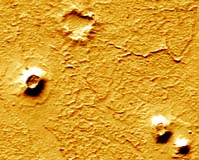| . |  |
. |
 San Diego - October 26, 1999 - High-resolution images from the Mars Global Surveyor (MGS) Mars Orbiter Camera (MOC) have revealed small cone-shaped structures on lava flows in southern Elysium Planitia, Marte Valles, and northwestern Amazonis Planitia in the northern hemisphere of the red planet. The most likely interpretation of these cones is that they may be volcanic features known as "pseudocraters" or "rootless cones".
San Diego - October 26, 1999 - High-resolution images from the Mars Global Surveyor (MGS) Mars Orbiter Camera (MOC) have revealed small cone-shaped structures on lava flows in southern Elysium Planitia, Marte Valles, and northwestern Amazonis Planitia in the northern hemisphere of the red planet. The most likely interpretation of these cones is that they may be volcanic features known as "pseudocraters" or "rootless cones".They share several key characteristics with pseudocraters on Earth: they are distributed in small clusters independent of structural patterns, are superimposed on fresh lava flows, and they do not appear to have erupted lavas themselves. Located in northwestern Amazonis Planitia near 24.8�N, 171.3�W, this high-resolution view is illuminated from the lower left and shows several possible psuedocraters (cone-shaped features with holes or pits at their summits) that occur on top of a rough-textured lava plain. Pseudocraters form by explosions due to the interaction of molten lava with a water-rich surface. Possible martian pseudocraters are of interest because they may mark the locations of shallow water or ice at the time the lava was emplaced. Viking Orbiter images have shown structures in other regions of Mars that were interpreted to be pseudocraters, but the interpretations were uncertain because the morphology was poorly resolved, it was unclear if they occurred on volcanic surfaces, and they have diameters as much as a factor of 3 larger than terrestrial pseudocraters. The cone-shaped morphology is well resolved in the cones imaged by MOC, and they have basal diameters of less than 250 m (273 yards), consistent with terrestrial examples. The cones rest on a surface with a distinctive morphology consisting of ridged plates that have rafted apart, which MOC team members have interpreted as the surface of voluminous lava flows. The surface shown here (above right) looks relatively fresh and has very few impact craters on it, which suggests that the lava flows and the cones are both geologically young. However, MOC images in other areas reveal such apparently young surfaces being exhumed (presumably by wind erosion) from beneath a blanket of overlying material. Impact processes may harden the blanket, or cover it with materials that cannot be removed by wind, so the wind erosion leaves behind elevated "pedestal craters". The cones shown here are not typical of pedestal craters, but it is important to consider this alternative interpretation. MGS MOC first began taking pictures of Mars in mid-September 1997. The planet that has been revealed by this camera is often strange, new, and exciting. The possibility that lava and water or ice have interacted to create features like psuedocraters indicates that Mars has had a diverse and complex past that researchers are only just begining to understand.
|
| |||||||||
| The content herein, unless otherwise known to be public domain, are Copyright 1995-2016 - Space Media Network. All websites are published in Australia and are solely subject to Australian law and governed by Fair Use principals for news reporting and research purposes. AFP, UPI and IANS news wire stories are copyright Agence France-Presse, United Press International and Indo-Asia News Service. ESA news reports are copyright European Space Agency. All NASA sourced material is public domain. Additional copyrights may apply in whole or part to other bona fide parties. Advertising does not imply endorsement, agreement or approval of any opinions, statements or information provided by Space Media Network on any Web page published or hosted by Space Media Network. Privacy Statement All images and articles appearing on Space Media Network have been edited or digitally altered in some way. Any requests to remove copyright material will be acted upon in a timely and appropriate manner. Any attempt to extort money from Space Media Network will be ignored and reported to Australian Law Enforcement Agencies as a potential case of financial fraud involving the use of a telephonic carriage device or postal service. |